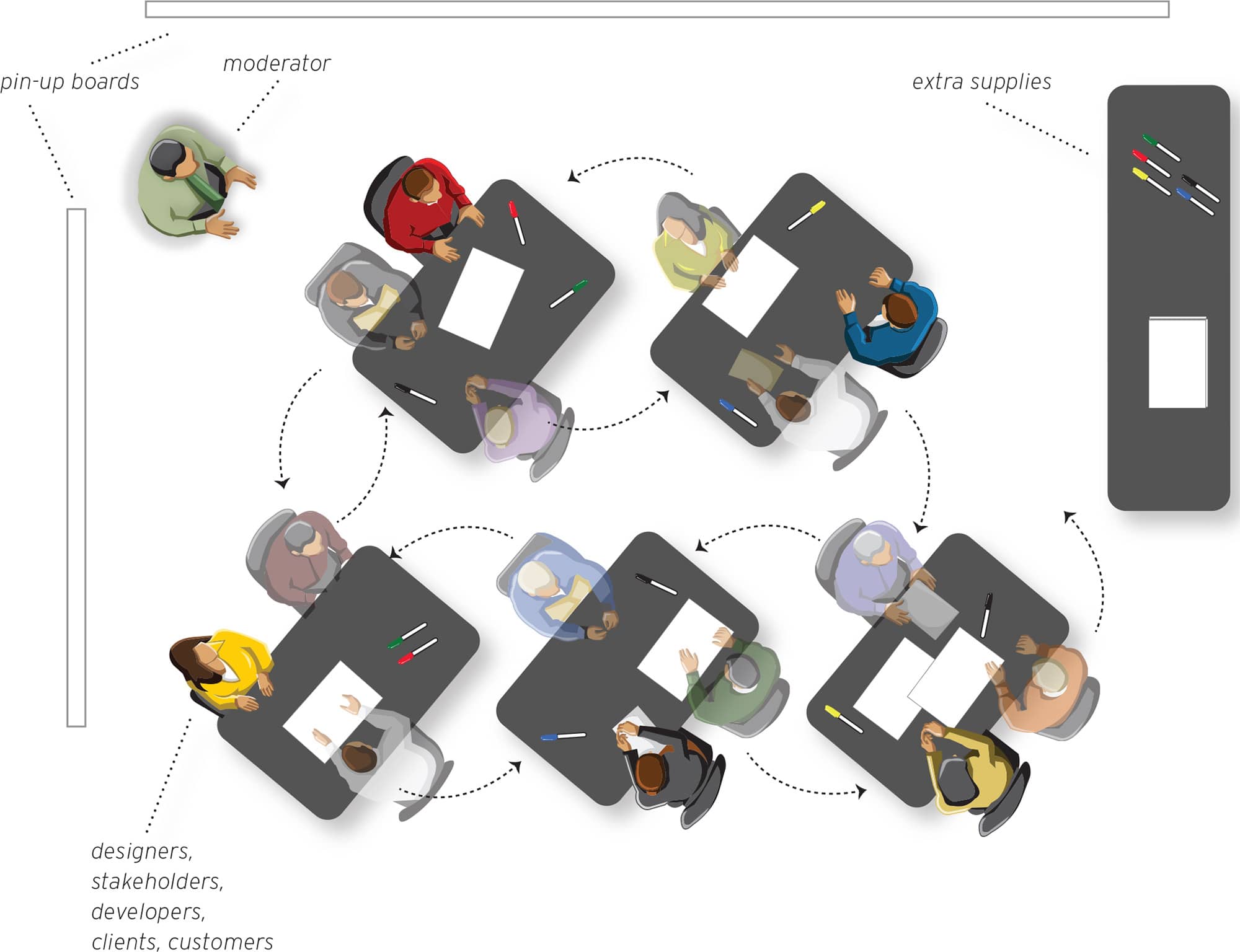RESEARCH METHOD • SYNTHESIS / ANALYSIS TECHNIQUE
26 Design Charette

When superior design features and characteristics inspire subsequent rounds of ideas, the end result is more likely to be an optimized design solution.1
Design teams flourish when they have a creative environment to explore and share ideas freely, and are expected to leverage and build off each other’s best ideas. A design charette is a workshop-style technique that provides a collaborative space that allows for this creation and cross-pollination of design ideas to occur. Designers and non-designers—including project stakeholders, engineers, and users—can participate in a design charette. It can be used to explore ideas about opportunities of a large-scale design challenge, or generate possibilities regarding a very specific interface (where it is more commonly referred to as parallel prototyping).2
The method is inspired by the process of biological natural selection and genetic algorithms,3 which seeks to test and select the strongest qualities as the basis for the next generation. This process, when applied over several generations, results in a population (or in the case of a design charette, a design solution) that is optimized for success, given its various requirements.
When planning a design charette, select a physical space that will inspire creativity and the flow of ideas. There should be a public space for participants to come together and discuss the range of ideas, and work spaces for individuals or groups to generate design ideas. At each work space, provide tools to spur creativity: paper templates, pencils, erasers, color markers. The sessions should be decidedly low tech, and a moderator can help to keep things moving, take pictures, and make sure that each group has what they need. Design session outcomes can either be presented, or simply displayed in an area large enough for all participants to congregate and talk about the spectrum of ideas. It should be clearly communicated that each round of designs build off the preferred components identified in the prior cycle.
Oftentimes, more clarity can be achieved not by championing any one particular idea, but through the active comparison and contrast of many ideas.4 Use design charettes when you want to thoroughly explore a problem space and quickly generate a wide range of ideas. A charette can quickly produce dozens of concepts, but due to the speed of the technique it should be understood that the resulting concepts are rough drafts, or at best, low-fidelity prototypes. The iterative design process can further improve upon the superior design ideas, as can usability testing and other evaluative methods.5
1. The National Charrette Institute suggests that the term “charrette” originates from the École des Beaux-Arts in Paris. In the nineteenth century, it was not unusual for student architects to continue working furiously on the illustrations for their design presentations, even while riding in the school cart (en charrette) through the streets of Paris en route to submit the projects to their professors. Hence, the term was adapted into the current design-related usage to reflect its rapid pace.
2. McGrew, John F. “Shortening the Human Computer Interface Design Cycle: A Parallel Design Process Based on the Genetic Algorithm.” Proceedings of the Human Factors and Ergonomics Society 45th Annual Meeting, 2001: 603–606.
Nielsen, Jakob, and Jan Maurits Faber. “Improving System Usability Through Parallel Design.” IEEE Computer 29, no. 2 (1996): 29–35. Also available online at useit.com.
3. See note 2 (McGrew) above.
4. Tohidi, M., B. Buxton, R. Baecker, A. Sellen. “User Sketches: A Quick, Inexpensive, and Effective Way to Elicit More User Feedback.” Proceedings of NordCHI 2006, 2006.
5. Nielsen, Jakob, and Heather Dusurvire. “Comparative Design Review: An Exercise in Parallel Design.” ACM INTERCHI’93 Conference Proceedings, 1993: 414–417.

